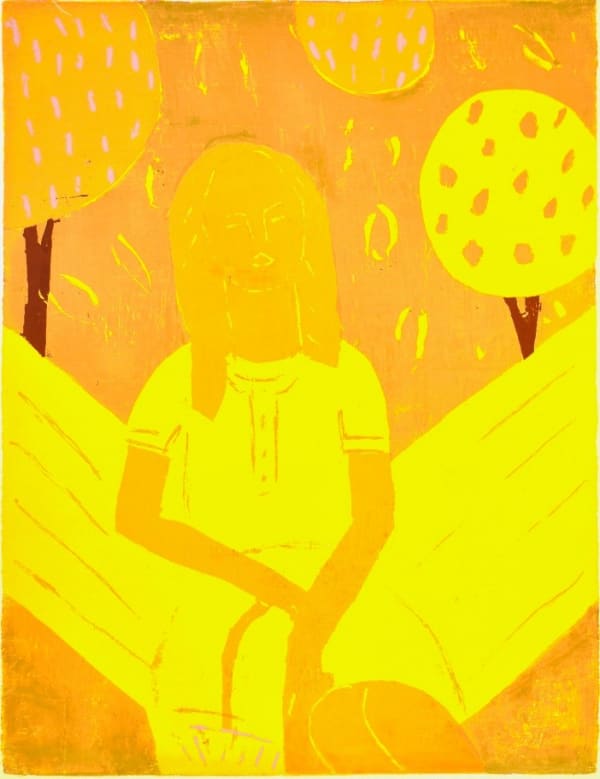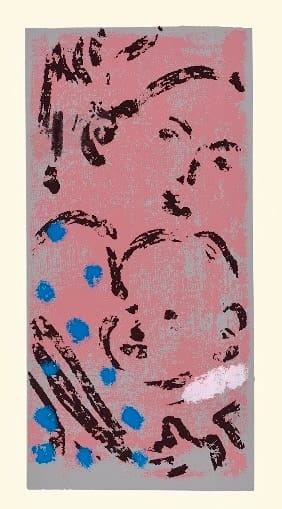Paul Crotto
-
 Paul CrottoBibaOil on Canvas89 x 79 cm£ 8,500.00
Paul CrottoBibaOil on Canvas89 x 79 cm£ 8,500.00 -
 Paul CrottoGreen/White Dress, Pink Fence Silk Screen28 3/8 x 22 in
Paul CrottoGreen/White Dress, Pink Fence Silk Screen28 3/8 x 22 in
72 x 56 cm2/10£ 1,795.00 -
 Paul CrottoOriental Still Life in Blue, ParisOil on Canvas90 x 70 cm£ 9,500.00
Paul CrottoOriental Still Life in Blue, ParisOil on Canvas90 x 70 cm£ 9,500.00 -
 Paul CrottoBoy in a Chair, studioSilkscreen32 1/4 x 25 1/4 in
Paul CrottoBoy in a Chair, studioSilkscreen32 1/4 x 25 1/4 in
82 x 64 cm1/14 -
 Paul CrottoClemantine BowlInk on Japan Paper29 1/8 x 24 3/4 in
Paul CrottoClemantine BowlInk on Japan Paper29 1/8 x 24 3/4 in
74 x 63 cm -
 Paul CrottoHammockSilkscreen31 7/8 x 26 in
Paul CrottoHammockSilkscreen31 7/8 x 26 in
81 x 66 cmEdition of 5 -
 Paul CrottoMother & BabySilkscreen19 7/8 x 27 1/8 in
Paul CrottoMother & BabySilkscreen19 7/8 x 27 1/8 in
50.5 x 69 cmEdition of 30 -
 Paul CrottoOrange Nude, Green Spot TowelSilkscreen
Paul CrottoOrange Nude, Green Spot TowelSilkscreen
Paul Crotto (born 1922, New York - died 2016, Paris) was a distinguished French-American painter, sculptor, and printmaker whose dynamic career spanned several decades and continents. His work is celebrated for its versatility, depth, and technical prowess, leaving an indelible mark on the art world.
Early Life and Education
Born in New York in 1922, Paul Crotto demonstrated an early affinity for the arts. He pursued formal education at the prestigious Art Student League in New York, where he laid the foundation for his artistic career. Eager to expand his horizons, Crotto traveled to Europe in the early 1950s, immersing himself in the rich artistic traditions of the continent.
He spent two years at the Accademia di Belle Arti di Firenze in Italy, honing his skills and absorbing the influences of the Renaissance masters. Following his studies in Florence, Crotto moved to Paris, the epicenter of the modern art movement. There, he rented a studio in the vibrant Montmartre district and studied for two years at Fernand Léger’s Academy. During this period, he also made engravings at Atelier Lacourière, where he met and collaborated with prominent artists such as Henri Matisse, Joan Miró, Pablo Picasso, Marc Chagall, André Derain, and Jean Fautrier.
Career and Achievements
In the early years of his career in Paris, Crotto worked as an art teacher at the American School, sharing his knowledge and passion with aspiring artists. Between 1955 and 1959, he visited Deià, Mallorca, on the recommendation of his friend William Waldren. The idyllic setting of Deià, described as ‘a paradise on Earth for artists, writers, and poets,’ deeply inspired Crotto, and he became an integral part of its artistic community. There, he forged a lasting friendship with poet Robert Graves and frequently returned to the village throughout his life.
Crotto’s talent was soon recognized by the French gallerist Jeanne Castel, who invited him to exhibit his work in 1961. This marked the beginning of a prolific exhibition career. Crotto’s work was regularly showcased in solo and group exhibitions across Europe and the United States. In 1963, he was awarded the prestigious “Prix International de Villeneuve-sur-Lot” in France, further cementing his reputation as a significant contemporary artist.
His paintings and silkscreens have been included in renowned art collections worldwide, including those of Claude Raphaël-Leygues and Lawrence Malkin. Crotto’s work was also prominently featured in major art salons such as the Salon d’Automne, Salon du Dessin et de la Peinture à l’Eau, Salon de la Jeune Peinture, and Comparaisons at the Museum of Modern Art in Paris.
Notable Exhibitions
Solo Exhibitions:
• Galerie Jeanne Castel, Paris, 1961, 1962
• Galerie Blanche, Stockholm, 1963
• City of Villeneuve-sur-Lot, 1963
• Galerie René Drouet, Paris, 1964, 1968
• Musée d’Art International, San Francisco, 1965
• Galerie Grave, Munich, 1966, 1967
• Sindin Harris Galleries, New York, 1969
• Maison Nationale des Artistes, Paris, 2016
Group Exhibitions:
• Mostra di Artisti Americani, Florence, 1951
• American Painters in France, Galerie Craven, Paris, 1953
• Dix Ans de Prix de Villeneuve-sur-Lot, Paris, 1964
• Obelisk Gallery, Boston, 1964
• Galerie Bernheim Jeune, Paris, 1965
• Sculptures des Peintres, Galerie Le Grall, Paris, 1967
• Galerie am Alten Hof, Munich, 1967
• School of Paris, Galerie Juarez, Los Angeles, 1967
• Artists of Europe and Israel, Riverdale, New York, 1968
Legacy
Paul Crotto’s artistic journey is a testament to his enduring dedication and passion for the arts. His ability to blend traditional techniques with modernist influences resulted in a unique and compelling body of work. Crotto’s contributions to the art world continue to inspire and influence contemporary artists, and his legacy lives on through the many collections and exhibitions that feature his work.








